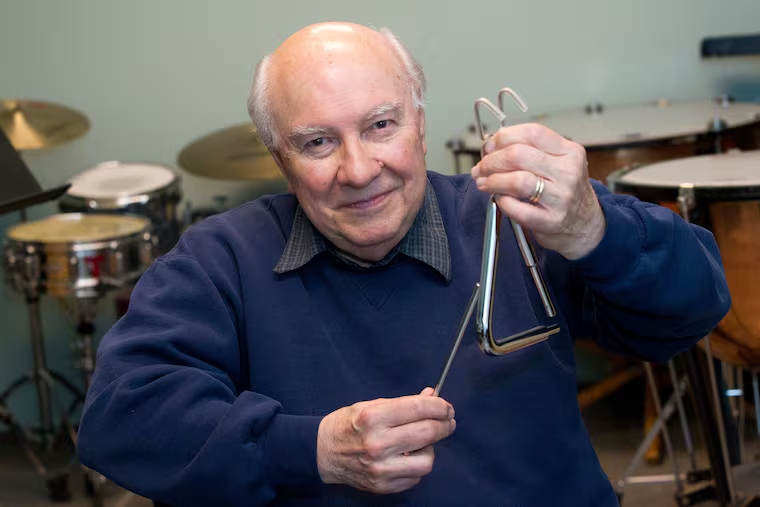Philadelphia Orchestra’s Alan Abel, 91, was ‘one of the great orchestral percussionists’
He designed a triangle used in the Philadelphia Orchestra and orchestras everywhere.

- Alan Abel
- 91 years old
- Lived in Bala Cynwyd
- He was a Philadelphia Orchestra percussionist
Almost anyone who has thrilled to the exclamation marks of the triangle in a Brahms symphony or fairy-dust accents of the small metallic instrument in a Liszt piano concerto knows the work of Alan Abel.
He wasn’t only a longtime percussionist with the Philadelphia Orchestra, but a builder of instruments. His particular take on the orchestral triangle was so successful that it became used in orchestras all over.
Mr. Abel, 91, also taught widely, wrote and edited texts on orchestral percussion repertoire, helped to restore parts of Ardmore Presbyterian Church, and performed as a substitute player with the Philadelphia Orchestra long after his 1997 retirement from the group. He died Saturday, April 25, at Lankenau Medical Center in Wynnewood from complications of the coronavirus, his family said.
Mr. Abel, most recently of Bala Cynwyd, was a major influence on the percussion orchestral realm in the United States, Canada, Asia, Mexico, and parts of Europe, said Philadelphia Orchestra timpanist Don S. Liuzzi.
“He was one of the great orchestral percussionists,” said Liuzzi. “He was renowned as a snare drum master, but in everything he did, in all of his orchestral playing, it was about fitting in with the music, which mirrored his humble nature. It wasn’t about being flashy. There was a grace about his playing.”
Born Dec. 6, 1928, in Hobart, Ind., Alan Daniel Abel attended the Eastman School of Music, graduating in 1951. He served in the Air Force from 1951 to 1953 and then joined the Oklahoma City Symphony.
One of the guest conductors who passed through that orchestra was Leopold Stokowski, who, in a newspaper interview, singled out Mr. Abel’s playing. The young percussionist sent the newspaper clipping to the Philadelphia Orchestra and asked to be considered for any openings, Mr. Abel told the Percussive Arts Society, in whose Hall of Fame he was inducted in 1998.
“He was the type of teacher who could make anybody better.”
An opening came, he auditioned, and began as third percussionist in 1959. He advanced to the assistant principal spot in 1973 and became associate principal in 1988.
Over the years, he was a standout on any number of instruments, whether it was the bass drum in Johann Strauss Jr.'s “Thunder and Lightning Polka,” the snare in Rachmaninoff’s The Bells, or tambourine in Wagner’s “Overture” to Das Liebesverbot.
Mr. Abel and fellow percussionist Fred Hinger often worked together to ponder how instruments could produce sound that would carry in the Academy of Music, said Liuzzi. A stand Mr. Abel created for suspending the bass drum has become standard equipment in the field.
The triangles he designed have “resonance and an ability to really cut through the orchestra,” Liuzzi said. “It’s very popular. For a while it was the only top-notch triangle.”
He taught at a number of schools, including, from 1973 to 2019, Temple University. More than a third of notable American orchestras have a percussionist who studied with Mr. Abel or with one of his students, said Liuzzi.
He had been slated to lead a class via Zoom on April 21 but was hospitalized the day before, said Mr. Abel’s daughter, Marianne.
“He was the type of teacher who could make anybody better,” said Peter Wilson, a freelance percussionist based in Phoenix who studied with Mr. Abel at Temple and privately. “He had a systematic way of doing things, so it was impossible not to improve if you did what he said.”
He also geared his training to help students succeed in the cut-throat audition circuit.
Said Wilson: “He’s hard to match for placing students in serious, reputable orchestras."
Mr. Abel is survived by his wife of 68 years, Janet Voorhies Abel; children Marianne Chenoweth, Alan, and Paul; seven grandchildren; 17 great-grandchildren; and a brother.
Services are expected later.